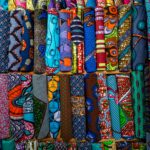The Goo Goo guide is a year long series released monthly written by Jennifer Chen-Su Huang. The Goo Goo Guide follows Jennifer during a year long artist residency in Taiwan through a Fulbright Scholarship. Join us as we follow Jennifer on her journey! The series is released through our Quarterly issues from Autumn 2017-2018, subscribe below for monthly reminders to read the Goo Goo Guide!
As part of our introductions, on the first day of a fiber workshop this past summer at the Haystack Mountain School of Craft, we were asked, “if you were a textile, what kind of textile would you be?” My immediate response was: Felt. Not only because of the name, though I do love the name, Felt.
It connotes softness, and being the past tense of feeling, a sensorial and emotional action, and naturally, I gravitate towards the word. But I chose felt because I think of my make-up as such, agitated fibers pressed up against one another in a forceful and seemingly disordered fashion. Though on a molecular level, there is an underlying logic to the compressed fibers which allows for the creation of cloth.
Some days I think weaving is more accurate of who I want to be; I admire the careful intentionality behind the act of weaving. A pattern signifying much more than itself slowly emerges in the cloth. In the case of the Taiwanese Atayal weavers, these patterns convey a distinct identity, a sense of belonging within a larger community. The gradual accumulation of thread amounts to a story, one that deserves to be told.
Inspired by cultural critic and scholar Ann Cvetkovich, who writes in Depression: a public feeling, “Like spiritual practice, creative practice – and scholarship as creative practice – involves not knowing, trusting to process and to a holistic intelligence that encompasses body, mind, and senses in order to see what happens, rather than having an answer to writing a dissertation, transforming depression, or planning a life,” I am going into this next year in Taiwan with an open attitude, allowing the experience to shape my research.
Acknowledging the influence of Cvetkovich’s method of memoir as research, I want to make this professional yet personal journey relevant to the public, whether that be through the discussion of indigenous weaving and craft traditions, the role it plays in restoring a person or a community’s sense of identity and belonging, or the general regenerative impact of handicraft. But I also must admit that I am more and more drawn to the aspect of confessional writing despite its bad rap.
In The Empathy Exams, Leslie Jamison states, “There are many ways to confess and many ways confession can reach beyond itself. If the definition of solipsism is ‘a theory holding that the self can know nothing but its own modifications and that the self is the only consistent thing,’ then little pushes back against solipsism more forcefully than confession gone public. This kind of confession inevitably creates dialogue.”
I am somewhat lost. Composed in a certain manner, I may fall into the model minority myth. I am not here to challenge you, but to cause you to behold. Upon second glance, I am all goo – wily, my secrets secrete. I lay my shame down at your feet.
Currently in Taipei, Taiwan. My Mandarin is clumsy. I can observe, eavesdrop, but ask me to speak, and I melt, fragmented phrases uttered in multiple languages. My Mandarin always slips into Taiwanese.
I am the second daughter of Taiwanese immigrants. Born in New York and raised in California, I am aware of the melanin in my skin, how it marks my difference.
I slip into a variety of roles, a rotating closet of assumed identities: the doting daughter, the servile sister, ingrained Bible verses roll off her tongue, the four-eyed nerd, the artist dressed in black, yet another Asian girl dating a white man.
Lost in the sense that I cannot claim my being. Peel each layer off like string cheese. You will not get to a core. Strip by strip, I disappear.
My parents are from the South. My father has a thick accent, so I’m told, in Chinese and English. Like my melanin, his accent assures that he will never belong. He is an outsider, trying to make it in the big city, Taipei. His unpublished poetry and exquisite grades in math and science will eventually bring him to the United States.
My father’s mother was Part Ping-pu. She would marry my grandfather without argument. No outlet for her opinion, for her passion or rage, she witnessed the death of her first child, a daughter. Fingers caressing her wooden beaded gourd, she meditates.
The Ping-pu is an aboriginal tribe in Taiwan, who lived in the Plains. Theirs was a peaceful matriarchal culture that was quickly usurped by the Han Chinese settlers. I could not find much information about the Ping-pu in English, but I found much more information on another Indigenous group, the Atayal, who ferociously resisted assimilation. I wonder hopelessly if violence is the only way to defend and sustain one’s autonomy.
For the Atayal, weaving was a revered feminine craft that a woman must perfect before marriage. When she mastered the skill, she was given facial tattoos that symbolized her social standing – suitable for marriage. In order for men to earn their facial tattoos, they were required to behead a man outside their tribe. The Japanese colonizers were the preferred heads of choice. During the Japanese occupation of Taiwan, the government outlawed weaving, headhunting, and facial tattooing in an effort to exterminate their culture and enslave the Atayal as agricultural laborers.
Likewise, in my creative practice, I want to give voice to that which feels like goo goo. This is a guide with no instructions and no preconceived notions. In this series, I thank you in advance for accompanying me in this year of not knowing, in embracing a willingness to trust, to leave knowing in suspension, to make room to for new ways of seeing and thinking.







